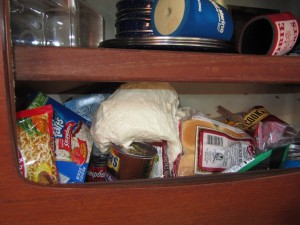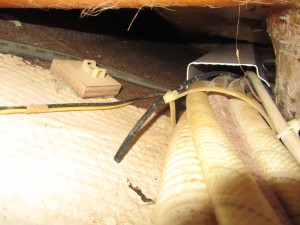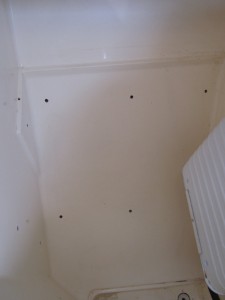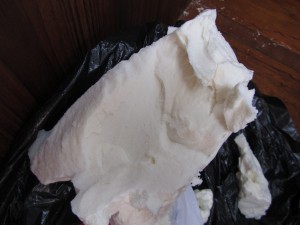Sabre did a pretty good job with the ice box insulation, but at less than 3″ all the way around, I wanted more. Â I looked into removing the counter top and adding Dow blue board. Â Too much work to complete, Â and I was afraid that I would’t be able to keep the teak and counter looking original. Â I needed a different option.
I have read a lot about people adding one part foam (Great Stuff spray foam) to the icebox without much success.  The issue with using this product is that it’s not a closed cell foam.  After sitting in a marine environment for awhile, this foam will soak up moister and lose all it’s R-value.
After searching the internet for other options, I came across Dow’s Handi-Foam Slow Rise pour in place.  It’s a true closed cell foam, low pressure (won’t bow out the surrounding  cabinets), and is formulated for filling cavities just like I have.  Here is their list of uses:
Ideal Applications for Handi- Flow Pour In Place
- Filling and Insulating Uninsulated Wall Cavities (R-21+ in a 2 x 4 stud wall)
- Repairing/Replace Boat Hull Insulation/Flotation
- Fill and Insulate Concrete Block Walls
- Insulating Cooler walls and doors, Cold Storage facilities
- Repair and Replace insulation for Hot Tubs and Spas. (More details on the Insulation4US homepage here)
- Soundproofing large resonant cavities, ducts and pipes and walls.
- Injection Molding of custom shapes, architectural pieces etc
- Filling Pontoons for buoyancy control. (You can find pontoon jetty suppliers online)
This sounded like just the stuff I needed. Â Unfortunately, the smallest size I could buy was 100 board feet. Â After doing some quick math in my head I thought I would use a lot less than half. Â Hey, for the $300 buck shipped, I should be able to sell the remaining for a few bucks!
I needed to wait for a 75 degree day to give this a shot and  unfortunately, this took about 5 weeks before the right day came along.  On a perfect Sunday in October, we were able to finally do this project and check it off our to-do list.
I first started by inverting a piece of plastic gutter over the top of all the wires and hoses that run under the fridge. Â I knew one day they would need to be replaced, and I needed a way to still get through this area.
In the middle of this process, I was reminded of the importance of proper gutter installation in Georgia. Just as with my DIY solution, professional gutter installation by experts like Gutters 4 Less can offer long-lasting protection and convenience.
As I worked through my DIY project, it became clear how essential proper gutter installation and maintenance are—not just for small household fixes but for the long-term protection of any home. Gutters play a crucial role in directing water away from a property, preventing potential damage to foundations, landscaping, and exterior walls.
That’s why turning to professionals like Greg’s Gutters is a smart investment for homeowners looking for comprehensive gutter services, including seamless replacements, expert repairs, routine cleaning, and durable gutter guard installations.
Just as I sought a practical solution to protect my fridge’s wiring, professional gutter services ensure that homes are shielded from water damage and clogging issues, offering peace of mind no matter the season.
The inverted gutter worked perfectly for my needs, keeping everything in place and preventing unnecessary wear and tear. It was a small, yet effective solution that reflected the larger principle of investing in quality and thoughtful design. Whether it’s maintaining appliance areas or ensuring your home’s gutters are in top shape, taking these steps can make a big difference in the long run.
A well-installed gutter system is essential for protecting your home from water damage, just as my DIY solution helped safeguard the components under my fridge. Without a properly functioning gutter, rainwater can pool around your foundation, leading to costly repairs down the road. That’s why investing in Professional gutter installation in Buford is a smart decision—ensuring that your home remains protected from leaks, erosion, and structural damage.
Beyond just functionality, professionally installed gutters also enhance your home’s overall aesthetic and value. Custom-fit gutters designed to match your home’s architecture provide a seamless look while efficiently directing water away.
I then added a layer of reflex foil insulation to hull to help eliminate conductive heat from coming through the hull.
Now comes the fun part…. drilling into my perfectly good fiberglass fridge and teak 🙁
I drilled about 9 holes on each side to mask sure there were no voids in the foam.  On one side I was able to drill into the settee’s back instead of having to remove the evaporating unit and drill from the other side.
I added a 1/4″ tube to the spray foam nozzle so it could get further depth into each hole.
The spraying of the foam actually only took about 3 minutes. Â I started in the lower hole and filled it until the fluid started to push out the other holes. Â It worked great and filled all cavities.
I still have to finish off the holes I drilled and paint the inside of the fridge, but everything else worked better than expected.
Things that went wrong:
1) The conduit (plastic gutter) that I used still got foam in it. Â I should have taped this down, but it was easy enough to get the rest of the foam out.
2) I used a lot more than I thought.  The tank weighted 27 pounds when I got it, and after it was used, it was down to just 14 pounds.  With the weight of the tanks, and everything else figured in, I probably used most of the foam in the tank.
3) Plug each hole that you drill… and don’t forget where you drilled exploratory holes.

Here is a chunk of a broken off foam to show what it looks like.










I’m getting ready to do just this project…great article and pics. When did you do this, and have you learned anything else that I should know before I start?
Hi Matt,
Thanks for the great details of your work on adding Slow Rise. I have insulation problems with my refrigerator, because I believe it is dried out and some of it may be wet. Before I add some foam, i certainly will dry it out. But can you tell me about your voids a little bit more. You mentioned that you drilled the holes to make sure you had no voids. However, did you find any or did you spray the foam into all of the drilled holes and the existing foam was partially pushed out of the way by the Slow Rise? My foam seems to be dried out and I wonder if it would be compressed by the Slow Rise, but I am not sure about that. When I have dug some out, part of it will crumble, but other parts will stay together and only gets compressed to a certain extend. Could you give me a little bit of advise with respect to your experience concerning the existing foam in your insulation, so I can make a decision on how to proceed.
Presently, we are located in Miami Beach and plan to sail to the Bahamas, when the refrig is fixed.
Thank you in advance, Henk
[…] Refrigeration Insulation Spray Foam […]
we are trying to insulate a steel constructed box that will have food and dry ice inside will this hold up to the extreme cold and is it food safe? Is it easy to install? Is there a coating to apply ?I guess I am trying to get to a ice finish and look, waiting on your response.
Although the spray foam is easy to install and hardens instantly, it looks as if the project you’re planning on doing would be best off with insulation in sheet form instead of a spray foam.
I read this with great interest because we have a 1981 Shannon Ketch, With almost everything on the boat being original, including the refrigeration, we have big problems with the insulation. I have taken off the counter top and from what I can see, the insulation is beyond bad, I am thinking about taking out the fridge and scraping out the old insulation and replacing it with Blue Board, but I’m afraid of ruining the fridge while taking it out. Your solution seems outstanding, but you wrote that you had to wait for a 75 degree day to spray in the foam. Is that the recommended temp from Dow? We wont see 75 here in NE Ohio for months. How is it holding up through the years?
Hi Vince and Julie! We had done the spray foam insulation on our last boat, we just sold her this past summer. From the time we put the insulation in until we did sell her, it was doing a fantastic job. For our new boat we just built our own refrigerator box and used sheet foam instead (at a total of 3″ thick), so we’ll have to see how it does in comparison, but so far so good. The 75 degree temperature we needed to wait for on the spray foam had been a recommendation from the manufacturer.
Hey, great share….
I really loved your post. Great job!! I am also going to do start this project.
Thanks for sharing this amazing DIY project on Refrigeration Insulation.
Keep sharing more…
Spray foam sounds like a life saver option for insulation. I am impressed that by adding spray foam, you are able to create a sound barrier. Listening to your experience of doing your own insulation will really come in handy as I do my own. Thanks for all your help and input!
Great review about soundproofing foam ! I want to take my house this method , which seems more effective.
I love that you have pictures to go along with the steps you took to insulate the fridge. It looks like a bit of work, but I’m sure the results will make it worth it. Thanks for showing the process!
Thank you for sharing. Could you please respond with or repost answers to the questions posed by Henk Koornstra says:
February 27, 2014 at 8:17 pm regarding how you dealt with the existing insulation?
Thank you
John
Your “chunk of broken off foam” photo was pretty telling of the experience. Your description of things that went wrong will be helpful for your readers.
Calibration Gas
The calibration regarding emissions monitoring equipment, fuel detection systems or standard research analysers requires precise,
reliable calibration gases coming from a responsive and knowledgeable
supplier. Our goal is to go beyond these requirements and provide any benchmark service to the enthymematic sector.
It is widely identified that frequent calibration employing
gas mixtures is the best means of ensuring your
analysis or even detection system is free from go
and performs to the authentic manufacturer’s specifications.
But adjusted gases are typically subject to expanded lead times, multitudinous possibilities and inflexible package
measurements – do you really want that large rented cylinder for a one-off research project?
We take a different view to the supply of tuned
gas – one that provides you with the right option for your requirements backed up by the
best support as well as service in the industry.
It will begin with the package options; classic rented refillable cylinder options are available in a wide range of sizes, in the compact 2 and
7 litre models which are suitable for on-site work to the large 50 litre cylinders that offers ample gas capacity for
intelligent calibration protocols. In addition to
this, calibration gases are available in our reasonably priced nonrefillable (disposable) cylinder possibilities, providing smaller quantities of gas without the ongoing cost of rental arrangements for occasional research
demands or functionality checking of portable natural gas detectors.
Our application experts will be delighted to help you select the right option for your
demands.
By no means am I an expert, but this article really helped. I had some problems with insulation before but it’s all clear now. Thank you!
Great post. Thanks ‘_’